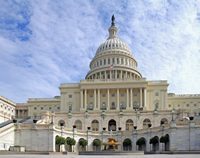AE2S echoes a recent American Water Works Association (AWWA) call to action for utility leadership to reach out to U.S. congressional delegates in support of the inclusion of funding for Per- and Polyfluoroalkyl substances (PFAS) treatment for drinking water systems and funding for PFAS management for wastewater and stormwater systems.
The American Jobs Plan includes $10 billion in funding to monitor and remediate PFAS in drinking water. However, wastewater should also be included in this funding, to provide help for utilities to abide by future PFAS federal regulations for industrial pretreatment and effluent.
H.R. 1915, the Water Quality Protection & Jobs Creation Act of 2021 includes $1 billion for the Clean Water State Revolving Fund program through fiscal year 2026, to help wastewater utilities comply with any federal effluent limitations or pretreatment regulatory obligations. Grant funding in the legislation includes:
- Programs to control water pollution;
- Pilot projects related to watershed management of wastewater discharges (e.g., sewer overflows or stormwater discharges) during wet weather;
- Alternative water source projects, including projects to reclaim stormwater;
- Measures to manage, reduce, treat or recapture stormwater, such as sewer overflows.
H.R. 1915 also requires the U.S. Environmental Protection Agency (USEPA) to award grants to owners of publicly owned wastewater treatment plants to treat contaminants of emerging concern, such as PFAS.
The USEPA says water and wastewater infrastructure in the United States requires nearly $750 billion worth of investment over the next two decades to maintain the current level of service. The cost of removing PFAS from wastewater will be an enormous financial burden to utility ratepayers, as they already shoulder the cost of repairs, improvements, and maintenance. The AWWA says PFAS should be controlled at the source, as that is the most cost-effective solution to removing the manmade chemicals. Federal regulations including the Toxic Substances Control Act (TSCA), Clean Water Act (CWA), and the Resource Conservation and Recovery Act (RCRA) should be leveraged to remove PFAS from our environment BEFORE it enters the drinking water, wastewater, or stormwater systems.
Federal delegates need to understand that regulatory actions can ensure the sources of PFAS are better controlled, while including funding in infrastructure bills to help utilities with the cost of removing PFAS are both critically important. You can find contact information for U.S. Senators and Congress members by visiting this website.

